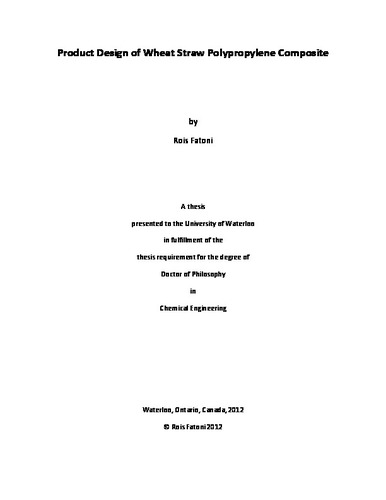| dc.description.abstract | The use of wheat straw and other agricultural by-product fibers in polymer composite materials offers many economical and environmental benefits. Wheat straw has been recently commercialized as new filler for polypropylene thermoplastic composites in automotive applications. However, to expand its application in the automotive industry and other sectors where highly-engineered materials are needed, a systematic database and reliable composite property models are needed. For this purpose, this research was systematically conducted.
A product design approach is used in studying wheat straw polypropylene (WS-PP) composite. A set of thermoplastic composite specifications relevant to several automotive parts was used as a basis for the customer needs which give the direction to the entire product design of thermoplastic composites based on polypropylene and straw. Straw fibers were produced by grinding and sieving (without any other treatment). These fibers were used in the formulation of polypropylene thermoplastic composites to understand the variable that can contribute to minimize production cost, maximize product performance and maximize wheat straw utilization (fraction of renewable material).
The variation in chemical composition due to plant variety (parts of the plant, location of harvesting and seasonality), the bonding incompatibility between hydrophobic polypropylene matrix and hydrophilic straw fiber, along with the heterogeneity of fiber size and shape, has made wheat straw polypropylene composite a complex system. This complexity causes the mechanistic approach of composite modeling in the well-established composite theory difficult to be applied, since modeling the contribution of natural fibers to the performance of thermoplastic composites is not as straightforward like in the case of homogenous glass fiber (with same shape, diameter and narrow length distribution). Alternatively, a statistical approach of modeling by using designed experiments was used in this research.
The Mixture and Process-Mixture Experimental Design methodologies were applied to develop response surface models that can be used to correlate input properties and formulation of these thermoplastic composites to the final properties of the product. The models obtained can then be inverted to predict the required properties and formulations using fiber (straw), matrix (polypropylene), and additives (coupling agent) as the main components for a specified product performance. The prediction includes the fiber grading (size and aspect ratio) and classification in order to maximize fiber utilization for different needs of composite products.
The experiments were designed based on the analysis of the existing data provided by previous research works of wheat straw polypropylene composite system in our laboratory and by experimental data generated during this research. The focus of the analysis was the determination of the factor(s), i.e., the independent variables of the experiments and their acceptable levels. The response variables being measured were chosen based on the required specifications of targeted products.
A constrained three-component mixture design of experiment was conducted to develop models for flexural properties of WS-PP composite. The three independent mixture variables in this experiment were the weight proportions of: straw (as fiber), polypropylene (as matrix), and maleic anhydride polypropylene (as coupling agent). Statistical analysis results showed that the obtained models have met standard requirements of response surface models with good predictive capability. One of the important finding of this study was the formulation for optimum coupling agent proportion which gives the best flexural properties of composite.
The effect of straw fiber size on composite properties was investigated by using fiber length and aspect ratio as parameters to describe fiber size, instead of the size of sieves used in fiber preparation. Two-stage separation method was applied in the straw fiber preparation process. In this method, width-based separation was followed by length-based separation to obtain fiber fractions with distinct fiber length and aspect ratio. Samples of thermoplastic composites for measurement of physical properties were produced from each fiber factions at two different levels of fiber loading. The samples were compounded by twin-screw extrusion and specimens were prepared by injection molding. The fibers were then extracted from the samples after injection molding (using solvent) and their sizes were measured to investigate the fiber size reduction during the compounding and molding process. A comprehensive analysis was then performed to study the responses of stiffness, impact resistance and specific properties of these composites by including initial fiber sizes, fiber chemical compositions (measured as cellulose, hemi-cellulose and lignin), fiber size reduction during compounding/molding process, and fiber loading as factors. One of the important contributions of this study is fiber grading in terms of their sizes and their respective contributions to the final composite product properties.
Based on the previous results, a mixture design of experiment was performed on wheat straw – polypropylene / impact copolymer polypropylene (WS-PP/ICP) composite system. The objective of the experiment was to obtain response surface models that can be used to estimate some important properties required by a set of automotive product specifications. The optimum formulation of coupling agent obtained in the previous study was used to determine the fixed recipe of coupling agent; simplifying the composite system into a three-component mixture, i.e. straw (as fiber) and polypropylene (homopolymer and impact copolymer (polypropylene blend as matrix). Simulation of the models shows the superiority of using a blend of polypropylenes to balance the stiffness and impact strength of the composites and being able to reach three targeted product specifications. A case study was also performed to demonstrate that the models can be used to find optimum formulations to minimize material cost while meeting specifications of all targeted products.
Finally, a framework for wheat straw polypropylene product design and development is presented in this thesis. The framework can be used for designing polypropylene-straw thermoplastic composites with various combinations of fiber - polymer matrix - additive systems with different product attributes and specifications suitable for several applications in the automotive industry. | en |

